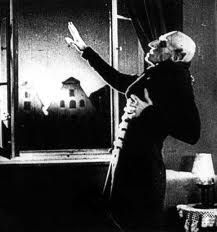Murnau's Nosferatu: a jewel of Expressionism
Let’s enter a realm of shadows, of fears, of Loneliness.

Those words depict very well the Expressionism’s quintessence.
This movement started at the beginning of the 20th century in the North of Europe, in Germany mostly.
It is a certain distorted vision of reality that is introduced, leading us to a world wrapped in darkness, uncertainty, anxiety, that might represent the stigmatas left by the World War I that plunged Germany into despair, being ruined and left as a complete wreck.
Murnau didn’t succeed in obtaining the author’s rights to adapt Bram Stoker ‘s Dracula, so he had to change the title and the characters’ names.
The Movie was shot in 1921 but released in 1922.
Nosferatu, a word that may come from the greek word “nosophoros” meaning: “bearer of diseases” has a very strong signification that is interesting to focus on.
The vampire might be perceived as a symbol of a destitute, bled-dry Germany.
Indeed, a biblical quotation says: “Blood is the Life”, a quotation many times quoted in the Dracula’s filmed adaptation, and said by the Count Dracula Himself.
To understand Nosferatu, both character and movie, it is to understand the Germany of the time.
Nosferatu is a god-forsaken creature, leaded into the darkness by its peers just like Germany after the War, being rejected in the depths of his ruined castle situated in a “land beyond the forest” where nobody can see him and help him to find any form of Salvation.
Nosferatu wanders about in the night, a very romantic and gothic vision of a man whose heart has been broken, obliged to feed on the blood of the living to find back a semblance of Dignity, of Life.
He represents a Germany in full depression, for all the symptoms of the disease are well depicted in the movie:
· Loss of motivation
· Loneliness
· Obscurity
· Fear
· Prostration
Darkness and Distortion are the main ingredients of Expressionism, it transcribes what a depressed mind contains.
Germany is a ghost in the night, roaming about without a goal, departed from any hope of Salvation, struggling to survive but not to live.
It is important to understand that Nosferatu is Germany’s reflection, and to point out this fact, Nosferatu has no reflection in a mirror, for being departed of soul, by extension, of identity, just like Germany is after the war.
At the end of the movie, the dark creature is vanquished by the sun light, Good triumphs over Evil, the Darkness are casted away by the Light. There is another biblical meaning here, for Jesus said : “To find the light it is to find me”.

Therefore we may understand that Germany’s hope is to be set free from the obscurity in which she is wrapped into, to find Peace and Salvation, just like Nosferatu who wants to be loved and set free from his horrible condition. He finally finds what he was looking for:
he finds Love thanks to the character of Ellen who gives up her life to save the world from the obscurity, presenting her as Martyr.
He finds the Light and so, Salvation, a new era may begin, Germany being saved from Obscurantism.
The movie is about to be projected on Monday, the 12th of March at the François-Rabelais University, please, do come and watch this masterpiece of Cinema.
An article by: Mercier Josselin.
